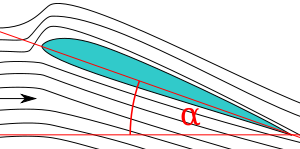Angle of attack

Angle of attack (AOA, , Greek letter alpha) is a term used in aerodynamics to describe the angle between the airfoil's chord line and the direction of airflow wind, effectively the direction in which the aircraft is currently moving. It can be described as the angle between where the wing is pointing and where it is going.
The amount of lift generated by a wing is directly related to the angle of attack, with greater angles generating more lift (and more drag). This remains true up to the stall point, where lift starts to decrease again because of flow separation.
Planes flying at high angles of attack can suddenly enter a stall if, for example, a strong wind gust changes the direction of the relative wind. Also, to maintain a given amount of lift, the angle of attack must be increased as speed through the air decreases. This is why stalling is an effect that occurs more frequently at low speeds.
Nonetheless, a wing (or any other airfoil) can stall at any speed. Planes that already have a high angle of attack, for example because they are pulling g or a heavy payload, will stall at speed well above the normal stall speed, since only a small increase in the angle of attack will take the wing above the critical angle.
The critical angle is typically around 15° for most airfoils. Using a variety of additional aerodynamic surfaces — known as high-lift devices — like leading edge extensions(leading edge wing root extensions), fighter aircraft have increased the potential flyable alpha from about 20° to over 45°, and in some designs, 90° or more. That is, the plane remains flyable when the wing's chord is perpendicular to the direction of motion.
Some aircraft are equipped with a built-in flight computer that automatically prevents the plane from lifting its nose any further when the maximum angle of attack is reached, in spite of pilot input. This is called the angle of attack limiter or alpha limiter. Modern airliners which limit the angle of attack by means of computers include the Airbus 320, 330, 340 and 380 series.
The pilot may disengage the alpha limiter at any time, thus allowing the plane to perform tighter turns (but with considerably higher risk of going into a stall). A famous military example of this is Pugachev's Cobra. Currently, the highest angle of attack recorded for a duration of more than 10 seconds is 89.8, performed in the Russian Su-35 (Flanker-E)/Su-37 (Flanker-F) family.
Sailing
In sailing, the angle of attack is the angle between a mid-sail and the direction of the wind. The physical principles involved are the same as for aircraft. See points of sail.

